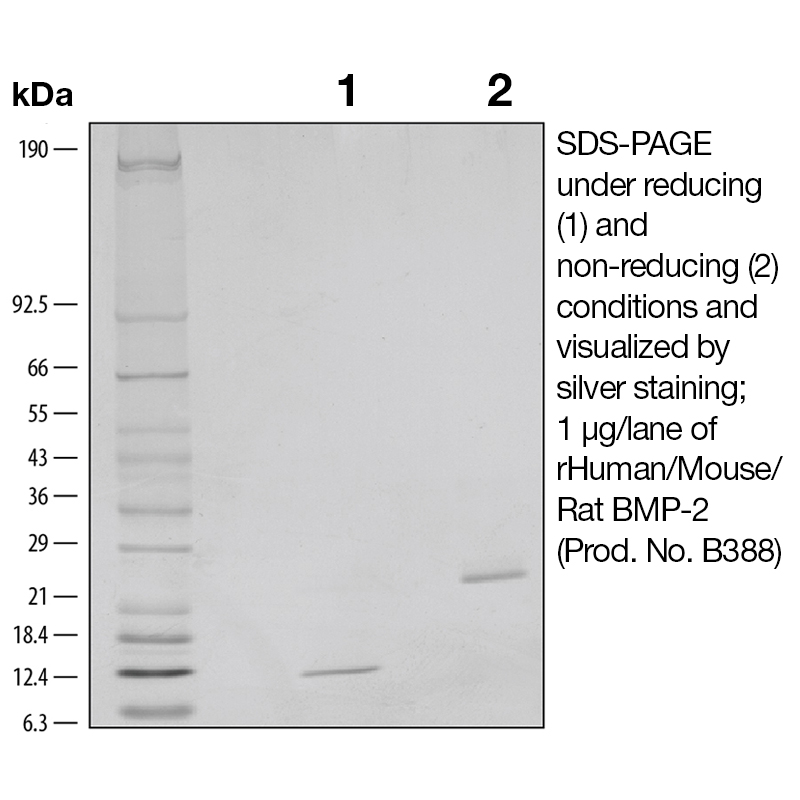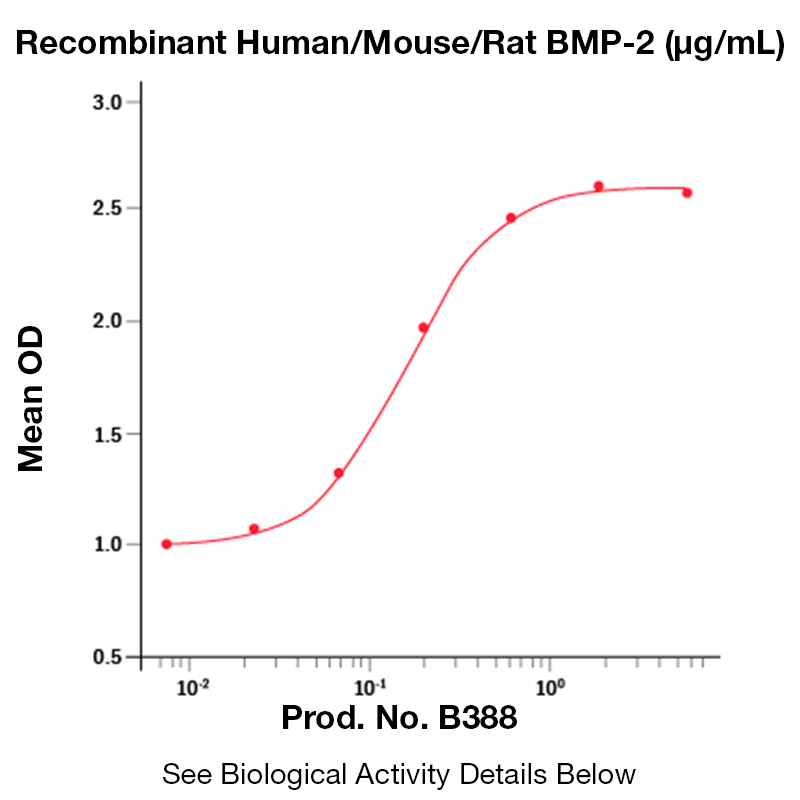Recombinant Human/Mouse/Rat BMP-2
Data
- -
- -
BackgroundBMPs (Bone Morphogenetic Proteins) belong to the TGF-beta superfamily of structurally related signaling proteins. BMP-2 is a potent osteoinductive cytokine, capable of inducing bone and cartilage formation in association with osteoconductive carriers such as collagen and synthetic hydroxyapatite. In addition to its osteogenic activity, BMP-2 plays an important role in cardiac morphogenesis. The functional form of BMP-2 is a 26 kDa protein composed of two identical 114 amino acid polypeptide chains linked by a single disulfide bond. Each BMP-2 monomer is expressed as the C-terminal part of a precursor polypeptide, which also contains a 23 amino acid signal sequence for secretion, and a 259 amino acid propeptide. After dimerization of this precursor, the covalent bonds between the propeptide (which is also a disulfide-linked homodimer) and the mature BMP-2 ligand are cleaved by a furin-type protease. Human and mouse BMP-2 and BMP-7 are 100% and 98% identical, respectively, at the amino acid level. Human BMP-2 shares 85% aa sequence identity with human BMP-4 and less than 51% aa sequence identity with other BMPs. Human BMP-7 shares approximately 60% - 70% aa sequence identity with BMP-5, -6, and -8, and less than 50% aa sequence identity with other BMPs. BMP-2 and BMP-7 are co-expressed in some embryonic tissues 6,7 and associate into a functional 38 kDa osteogenic dimer.8 In in vitro osteoblast differentiation assays and in vivo bone formation models, a BMP-2/BMP-7 heterodimer is significantly more potent than either homodimer. Bone morphogenetic protein 2 is shown to stimulate the production of bone and recombinant human protein (rhBMP-2) and is currently available for orthopaedic usage in the United States. Implantation of BMP-2 in a collagen sponge induces new bone formation and can be used for the treatment of bony defects, delayed union, and non-union. Bone morphogenetic protein 2 has also found its way into the field of Dentistry. Oral Surgery and Implant Dentistry in particular have benefited dramatically from commercially available BMP-2. Protein DetailsPurity >95% by SDS-PAGE and analyzed by silver stain. Endotoxin Level <0.01 EU/µg as determined by the LAL method Biological Activity The biological activity of Human BMP-2 was determined by its ability to induce alkaline phosphatase production by ATDC5 mouse chondrogenic cells. Nakamura, K. et al. (1999) Exp. Cell Res. 250:351. The expected ED<sub>50</sub>= 0.3-1 μg/ml. Amino Acid Sequence akhkqrk rlkssckrhp lyvdfsdvgw ndwivappgy hafychgecp fpladhlnst nhaivqtlvn svnskipkac cvptelsais mlyldenekv vlknyqdmvv egcgcr State of Matter Lyophilized Predicted Molecular Mass The predicted molecular weight of Recombinant Human BMP-2 is Mr 12.8 kDa. However, the actual molecular weight as observed by migration on SDS-PAGE is 12 kDa (reducing conditions) and 24 kDa (non-reducing conditions). Predicted Molecular Mass 12.8 Formulation This recombinant protein was lyophilized from a 0.2 μm filtered solution in 35% acetonitrile (CH3CN) and 0.1% trifluoroacetic acid (TFA). Storage and Stability This lyophilized protein is stable for six to twelve months when stored desiccated at -20°C to -70°C. After aseptic reconstitution, this protein may be stored at 2°C to 8°C for one month or at -20°C to -70°C in a manual defrost freezer. Avoid Repeated Freeze Thaw Cycles. See Product Insert for exact lot specific storage instructions. Country of Origin USA Shipping Next Day Ambient NCBI Gene Bank Certificate of AnalysisIMPORTANT Use lot specific datasheet for all technical information pertaining to this recombinant protein. |




